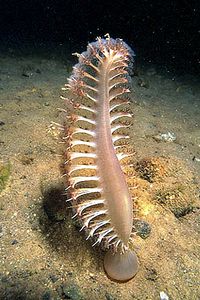Sea pen






Sea pens are a group of marine invertebrates belonging to the order Pennatulacea within the class Anthozoa of the phylum Cnidaria. They are named for their resemblance to quill pens due to their unique feather-like structure. Sea pens are colonial organisms, consisting of a primary polyp that anchors into the soft sediment of the ocean floor and secondary polyps that serve various functions such as feeding, reproduction, and defense.
Description[edit]
Sea pens can vary greatly in color, size, and shape, ranging from a few centimeters to over 2 meters in length. Their colors can be quite vivid, including shades of yellow, orange, pink, and white. The primary polyp, also known as the peduncle, burrows into the sediment and acts as a stalk from which the secondary polyps (autozooids and siphonozooids) extend. These secondary polyps are responsible for feeding, with many sea pens being filter feeders, capturing plankton and organic particles from the water column with their tentacles.
Habitat[edit]
Sea pens prefer soft, muddy or sandy substrates where they can anchor themselves. They are found in oceans around the world, from shallow to deep waters, but are more commonly located in deeper, more stable environments. Their distribution ranges from the intertidal zone to depths of over 6,000 meters, though they are most abundant and diverse in depths below 200 meters.
Ecology[edit]
Sea pens play a significant role in their ecosystems. They provide habitat and protection for various small marine animals, including certain species of fish, shrimp, and nudibranchs. Some species of sea pens have a symbiotic relationship with bioluminescent bacteria, which can cause them to glow in the dark, a phenomenon known as bioluminescence. This can be a defense mechanism to startle predators or attract prey.
Predators of sea pens include sea stars and nudibranchs, which can feed on their polyps. In response to threats, sea pens can retract into the sediment to hide.
Reproduction[edit]
Sea pens reproduce both sexually and asexually. Sexual reproduction involves the release of eggs and sperm into the water column, where fertilization occurs. The resulting larvae settle on the ocean floor and develop into a new primary polyp, which then gives rise to secondary polyps. Asexually, sea pens can reproduce through fragmentation, where a piece of the sea pen breaks off and develops into a new individual.
Conservation[edit]
While not currently listed as endangered, sea pens face threats from deep-sea trawling and other forms of bottom-contact fishing, which can damage or remove them from their habitats. Their slow growth rates and late maturity also make them vulnerable to overexploitation. Conservation efforts are focused on protecting their habitats and regulating fishing practices to ensure the sustainability of sea pen populations.
See Also[edit]
Ad. Transform your life with W8MD's Budget GLP-1 injections from $75


W8MD offers a medical weight loss program to lose weight in Philadelphia. Our physician-supervised medical weight loss provides:
- Weight loss injections in NYC (generic and brand names):
- Zepbound / Mounjaro, Wegovy / Ozempic, Saxenda
- Most insurances accepted or discounted self-pay rates. We will obtain insurance prior authorizations if needed.
- Generic GLP1 weight loss injections from $75 for the starting dose.
- Also offer prescription weight loss medications including Phentermine, Qsymia, Diethylpropion, Contrave etc.
NYC weight loss doctor appointmentsNYC weight loss doctor appointments
Start your NYC weight loss journey today at our NYC medical weight loss and Philadelphia medical weight loss clinics.
- Call 718-946-5500 to lose weight in NYC or for medical weight loss in Philadelphia 215-676-2334.
- Tags:NYC medical weight loss, Philadelphia lose weight Zepbound NYC, Budget GLP1 weight loss injections, Wegovy Philadelphia, Wegovy NYC, Philadelphia medical weight loss, Brookly weight loss and Wegovy NYC
|
WikiMD's Wellness Encyclopedia |
| Let Food Be Thy Medicine Medicine Thy Food - Hippocrates |
Medical Disclaimer: WikiMD is not a substitute for professional medical advice. The information on WikiMD is provided as an information resource only, may be incorrect, outdated or misleading, and is not to be used or relied on for any diagnostic or treatment purposes. Please consult your health care provider before making any healthcare decisions or for guidance about a specific medical condition. WikiMD expressly disclaims responsibility, and shall have no liability, for any damages, loss, injury, or liability whatsoever suffered as a result of your reliance on the information contained in this site. By visiting this site you agree to the foregoing terms and conditions, which may from time to time be changed or supplemented by WikiMD. If you do not agree to the foregoing terms and conditions, you should not enter or use this site. See full disclaimer.
Credits:Most images are courtesy of Wikimedia commons, and templates, categories Wikipedia, licensed under CC BY SA or similar.
Translate this page: - East Asian
中文,
日本,
한국어,
South Asian
हिन्दी,
தமிழ்,
తెలుగు,
Urdu,
ಕನ್ನಡ,
Southeast Asian
Indonesian,
Vietnamese,
Thai,
မြန်မာဘာသာ,
বাংলা
European
español,
Deutsch,
français,
Greek,
português do Brasil,
polski,
română,
русский,
Nederlands,
norsk,
svenska,
suomi,
Italian
Middle Eastern & African
عربى,
Turkish,
Persian,
Hebrew,
Afrikaans,
isiZulu,
Kiswahili,
Other
Bulgarian,
Hungarian,
Czech,
Swedish,
മലയാളം,
मराठी,
ਪੰਜਾਬੀ,
ગુજરાતી,
Portuguese,
Ukrainian